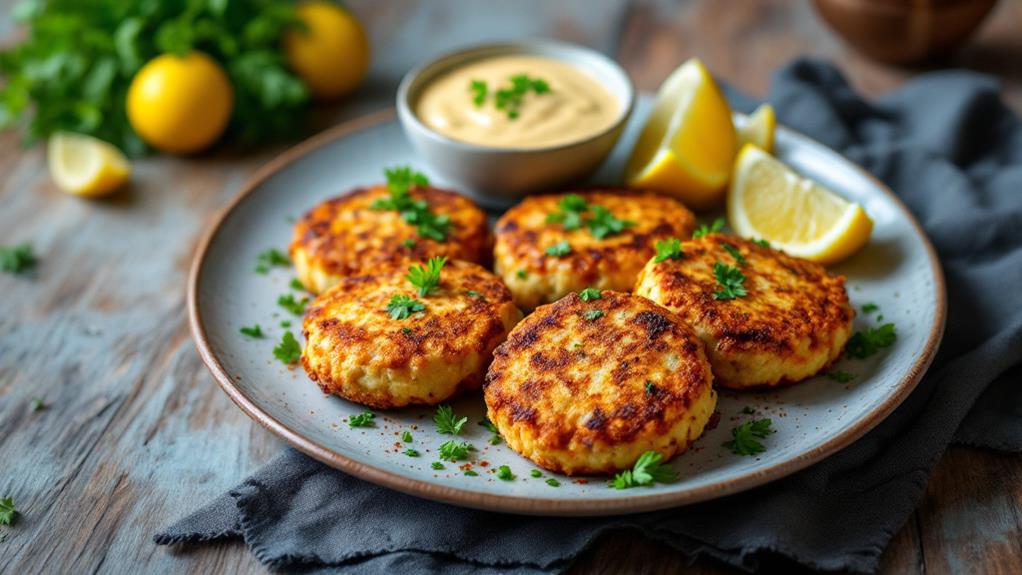You might not realize that fish cakes have been a culinary solution for centuries, transforming leftover fish into a beloved dish across various cultures. While you may be familiar with the classic versions, the world of fish cakes is surprisingly diverse, showcasing unique ingredients and preparation styles that reflect local traditions. As you explore the different types and regional variations, you'll uncover some intriguing culinary techniques and tips that can elevate your own fish cake creations. What's more, understanding the best sauces to accompany them can truly enhance your dining experience.
Key Takeaways
- Fish cakes originated as a way to preserve leftover fish and are now a staple in many coastal communities.
- Common fish used include cod, salmon, and mackerel, each offering unique flavors and textures.
- Popular regional variations exist, such as UK fish cakes and Southeast Asian keropok lekor, reflecting local cultures.
- Cooking methods range from frying and baking to steaming and grilling, each producing different textures and flavors.
- Pair fish cakes with sauces like tartar, spicy remoulade, or lemon-dill for enhanced taste and presentation.
History of Fish Cakes
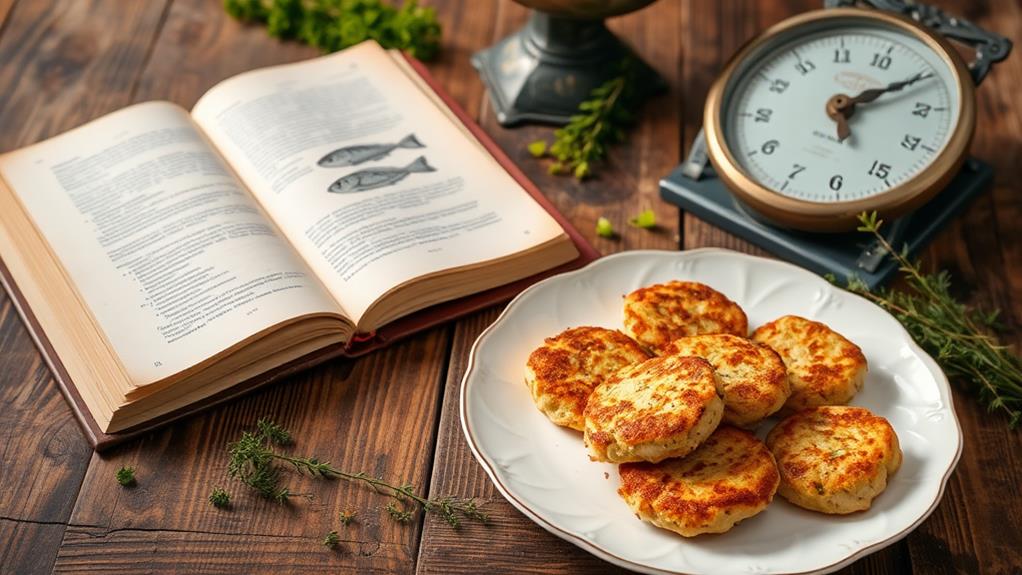
The history of fish cakes is as rich and varied as the flavors they embody. From ancient maritime cultures to modern dining tables, these delectable treats carry deep cultural significance. You might be surprised to learn that civilizations around the world have created their versions to maximize the nutritional benefits of fish, transforming simple ingredients into something extraordinary.
As you explore the origins, you'll find that fish cakes date back centuries, often crafted to preserve leftover fish and minimize waste. In coastal communities, they became a staple, serving not only as a tasty dish but also as a means of sustenance during lean times. Their versatility allowed them to adapt to local ingredients and tastes, making fish cakes a culinary canvas.
You're likely to appreciate how they provide a great source of protein, omega-3 fatty acids, and essential vitamins. This makes them not just a flavorful choice but a nourishing one as well.
Types of Fish Used
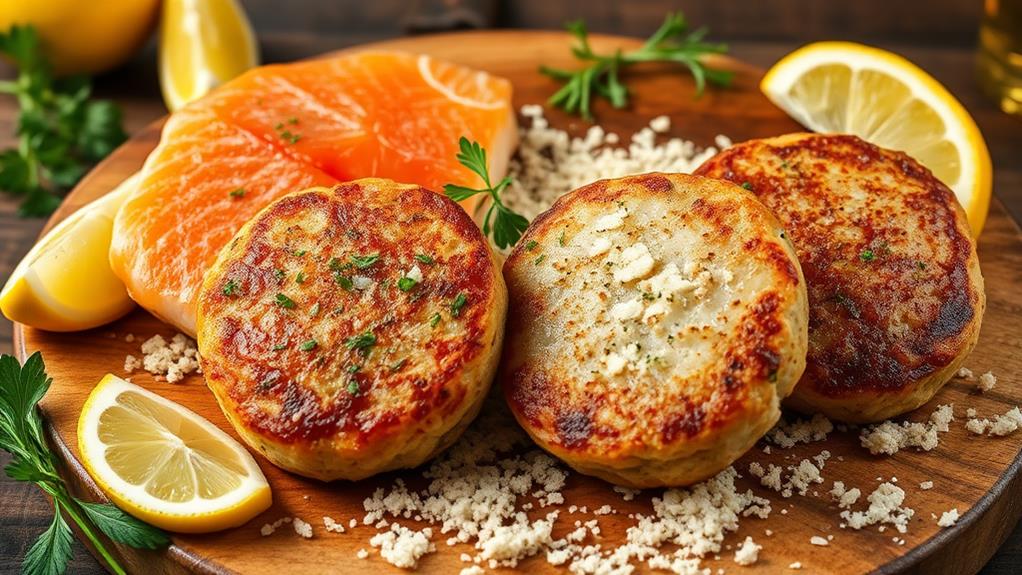
Often, cooks turn to a variety of fish when crafting their beloved fish cakes, each type bringing its unique flavor and texture to the dish. When you consider sustainable fish, options like cod, haddock, and pollock stand out. These species not only provide a mild flavor that blends beautifully with spices and herbs but also ensure you're making an eco-friendly choice.
For a richer, more robust flavor profile, salmon is a fantastic option. Its oily texture adds depth, making your fish cakes succulent and satisfying.
If you're looking for something a bit more adventurous, consider using mackerel. This fish has a stronger taste, which gives your cakes a bold character that pairs well with zesty sauces.
Don't overlook whitefish varieties, such as tilapia or sole; they offer a delicate flavor that works well in combination with other ingredients.
Ultimately, the type of fish you choose can transform your fish cakes from ordinary to extraordinary. So, explore these sustainable fish options and experiment with their distinct flavor profiles to create a dish that's not only delicious but also responsible.
Popular Regional Variations

Fish cakes showcase a delightful variety of regional twists that reflect local tastes and traditions. In the UK, for instance, you'll find the classic fish cake made with flaky cod, mashed potatoes, and a crispy breadcrumb coating.
Meanwhile, in Southeast Asia, you might encounter the flavorful keropok lekor, featuring fish blended with spices and deep-fried until golden brown.
Travel to Scandinavia, and you'll experience fiskekaker, where minced fish combines with cream and flour, resulting in a tender cake often served with a tangy sauce. Each version carries cultural significance, indicating how local ingredients and cooking methods shape these beloved dishes.
As you explore global influences, notice how spices and techniques from various regions create unique flavors. For instance, in the Caribbean, fish cakes often include a spicy kick from scotch bonnet peppers, showcasing the vibrant culinary landscape.
These variations not only tantalize your taste buds but also tell a story of the communities that cherish them.
Essential Ingredients
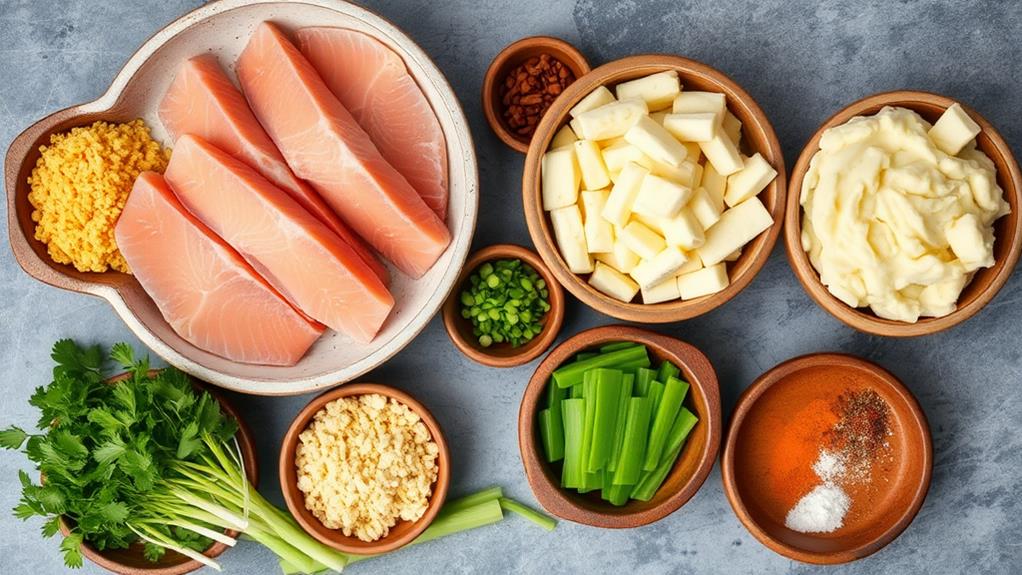
When creating delicious fish cakes, you'll find that the essential ingredients play a vital role in achieving the perfect texture and flavor. Start with fresh fish, like salmon or cod, as the base; they bring not just taste but also nutritional benefits, including omega-3 fatty acids that support heart health.
Next, consider adding starchy elements such as mashed potatoes or breadcrumbs. These ingredients help bind the mixture together while providing a satisfying texture.
Don't forget to incorporate herbs and spices for flavor enhancements—think dill, parsley, or a hint of cayenne pepper to elevate your dish.
Onions and garlic can add depth, bringing a savory aroma that makes your fish cakes irresistible. For a touch of creaminess, mix in some eggs or a dollop of sour cream; this creates a luscious mouthfeel that complements the fish beautifully.
Lastly, consider adding vegetables like grated carrots or bell peppers. They not only contribute crunch but also boost the nutritional profile of your cakes, making them a wholesome meal option.
With these essential ingredients, you'll be well on your way to crafting fish cakes that are both delicious and nourishing.
Cooking Methods

Cooking fish cakes can be a delightful experience, and choosing the right method can elevate your dish to new heights. You have several fabulous options, each offering a unique flavor and texture.
If you're after a crispy exterior, frying methods are your best bet. Heat oil in a skillet and fry until golden brown on both sides.
Alternatively, you can explore baking techniques for a healthier take. Simply place your patties on a baking sheet and pop them in the oven until they're crispy and cooked through.
Steaming options offer a gentle cooking method that keeps the fish cakes moist and tender. Use a steamer basket over boiling water for about 15 minutes, and you'll retain all those vibrant flavors.
Grilling tips can also add a smoky depth to your fish cakes. Preheat your grill and cook them on medium heat, ensuring you flip them carefully to avoid breaking apart.
Lastly, consider poaching styles for a delicate approach. Submerge the cakes in simmering broth until cooked, allowing for subtle seasoning to infuse.
Each method brings something special to the table, so experiment and find your favorite!
Tips for Perfect Fish Cakes
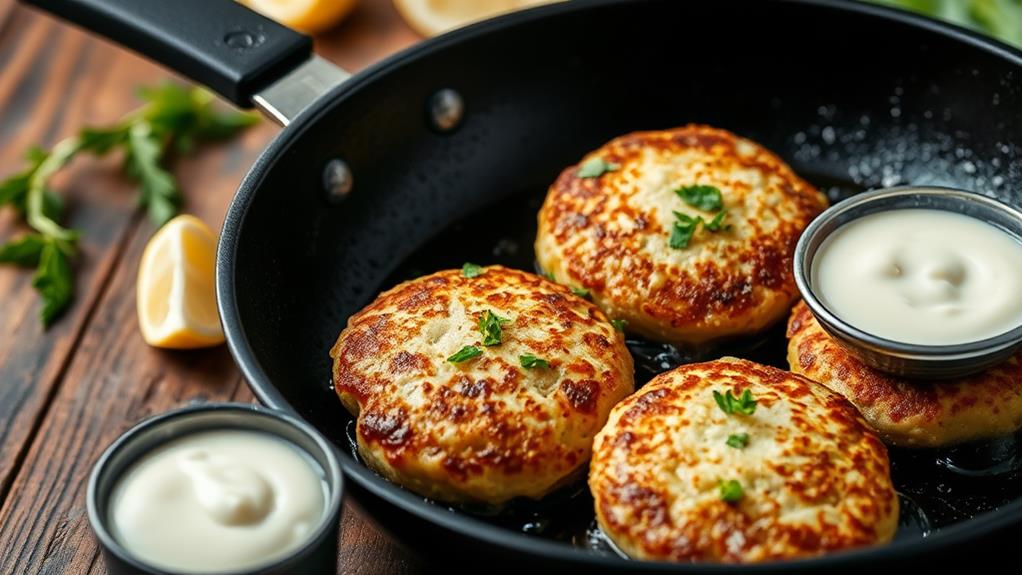
Achieving perfect fish cakes hinges on a few key techniques that can enhance both flavor and texture.
First, focus on your fish selection. Choose a combination of firm, flaky fish—like cod or haddock—along with a richer option, such as salmon. This mix not only adds depth but also creates a delightful texture balance.
Next, don't skimp on the binding agents. Potatoes or breadcrumbs help hold everything together while contributing to that satisfying crunch.
Be mindful not to overwork the mixture; gently fold in the ingredients to maintain a light, airy texture.
Seasoning is crucial, too. Fresh herbs, like dill or parsley, complement the fish beautifully and elevate the overall taste.
A squeeze of lemon or a dash of hot sauce can also bring a zing that makes your fish cakes irresistible.
Serving Suggestions

Fish cakes can be a delightful centerpiece for any meal, and the way you serve them can elevate the dining experience. Start by choosing the right plate—something vibrant or rustic to complement the golden hue of your fish cakes. For garnish ideas, consider a sprinkle of fresh herbs like parsley or dill. A lemon wedge on the side adds a zesty touch that brightens the dish.
Pair your fish cakes with enticing side dishes to create a balanced meal. A light, crunchy coleslaw or a fresh garden salad can add a refreshing contrast. If you're in the mood for something heartier, try serving them alongside roasted vegetables or a fluffy quinoa salad.
For an extra layer of flavor, consider a side of seasoned potatoes or a creamy risotto.
Don't forget to add a touch of color to your presentation; edible flowers or microgreens can make your plate pop. Remember, the way you arrange your food can enhance its appeal.
With these serving suggestions, you'll not only showcase your delicious fish cakes but also impress your guests with a beautifully curated dining experience. Enjoy!
Pairing With Sauces

To elevate your fish cakes further, pairing them with the right sauces can make all the difference. A well-chosen sauce enhances the flavor profiles of your dish, creating a harmonious balance that tantalizes the taste buds.
For a classic touch, try a zesty tartar sauce. Its creamy texture and tangy notes complement the fish cakes beautifully, bringing out their savory flavors.
If you're in the mood for something more adventurous, consider a spicy sriracha aioli. The heat from the sriracha adds an exciting kick, while the aioli's creamy consistency rounds out the dish.
Alternatively, a citrus-infused remoulade provides a fresh, bright contrast, perfectly highlighting the fish's natural sweetness.
For a more Asian-inspired experience, a soy-ginger dipping sauce can introduce umami richness, enhancing the fish cakes' taste while adding a delightful zing.
Don't forget the option of a simple lemon-dill sauce; its bright acidity and herbal notes elevate the dish without overpowering it.
Experiment with these sauce pairings to discover what resonates with your palate. Each sauce not only complements the fish cakes but also introduces a unique twist, making every bite an adventure.
Storing and Reheating Fish Cakes
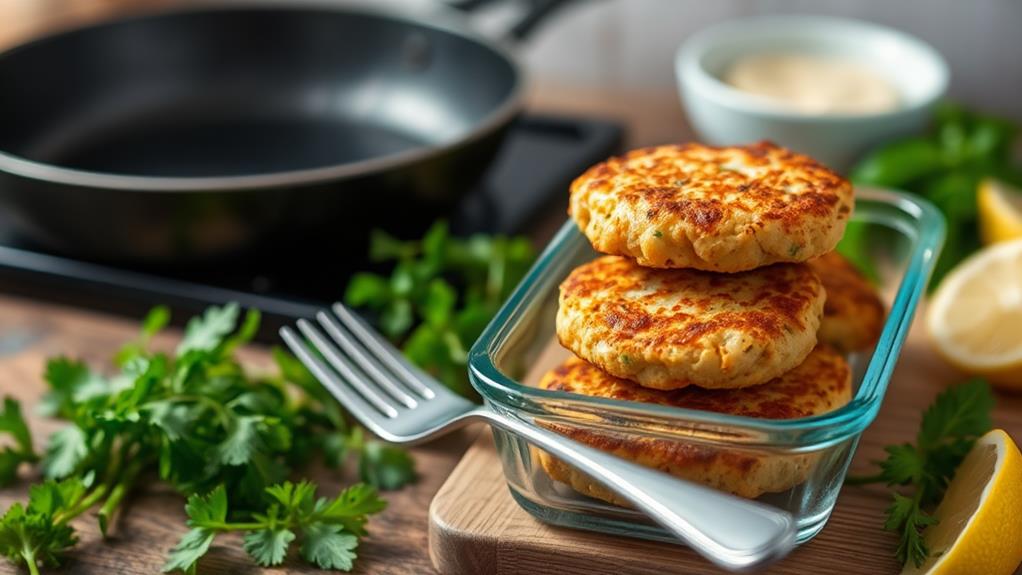
When you've got leftover fish cakes, knowing how to store and reheat them properly ensures they retain their deliciousness. Start by letting the fish cakes cool completely before storing them.
For short-term storage, place them in the best containers—airtight plastic or glass containers work wonders. Make sure to separate layers with parchment paper to prevent sticking. They'll last in the fridge for about three days.
If you want to keep them longer, consider using freezing techniques. Wrap each fish cake tightly in plastic wrap or aluminum foil, then place them in a freezer-safe container or a resealable bag. This way, they can last for up to three months without losing their flavor.
When it's time to reheat, avoid the microwave if you can. Instead, preheat your oven to 375°F (190°C) and place the fish cakes on a baking sheet. Heat for about 15-20 minutes, flipping halfway through, until they're heated through and crispy again.
Alternatively, you can pan-fry them in a little oil for that freshly cooked texture. Enjoy those scrumptious fish cakes just like the first time!
Frequently Asked Questions
Are Fish Cakes Gluten-Free?
Imagine a culinary treasure chest—gluten-free options await! Yes, some fish cakes can be gluten-free, especially when using gluten substitutes. Different fish varieties can create delicious alternatives, satisfying your taste without the gluten worries. Enjoy!
Can I Use Canned Fish for Fish Cakes?
Absolutely, you can use canned fish varieties in your recipes! They're convenient and packed with flavor. Just drain them well, mix with your favorite ingredients, and you've got delicious fish cakes ready to enjoy.
How Long Do Fish Cakes Last in the Fridge?
When you've lovingly prepared your dish, it's best to enjoy it soon. In the fridge, it'll stay fresh for about three days. Check for any odd smells or changes in texture as freshness indicators.
What Are Common Allergens in Fish Cakes?
When considering common allergens, you should be aware of fish allergies, which can trigger reactions. If you're cooking, think about ingredient substitutions to accommodate those allergies, ensuring everyone enjoys the meal safely and deliciously.
Can I Bake Fish Cakes Instead of Frying?
Absolutely, you can bake instead of frying! Using baking techniques gives your dish a lighter texture, while frying creates a crispy exterior. Experiment with temperatures to find the perfect balance for your delicious creation. Enjoy!
